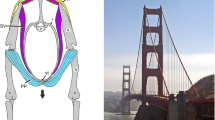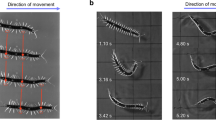Abstract
Based on similarity of motor patterns of lizards, crocodiles, birds and mammals, various authors have concluded that a number of homologous muscles across these taxa demonstrate neuromuscular conservatism. This hypothesis remains untested for more basal taxa. Therefore, a quantitative electromyographic study of the hind limb during treadmill walking (mean speed of 0.75 SVL/s) in the salamander Dicamptodon tenebrosus was undertaken. Muscles located ventrally on the hind limb become active just before foot placement on the substrate, and maintain activity through the first half of the stance phase. Dorsally located muscles begin activity at or just before the start of the swing phase, and fire through the first half of swing. Several muscles showed a secondary EMG burst during the stride. The second burst in most ventral muscles occurred in late stance. In all dorsal muscles with double bursts, the second burst occurred in the middle of stance. Comparison of electromyographic onset and offset values for Dicamptodon to those for presumed homologues in other tetrapods reveals similarity in activity patterns for all ventral and two dorsal muscles despite anatomical rearrangements, supporting the hypothesis of neuromuscular conservatism for some muscles but not others.
Similar content being viewed by others
Abbreviations
- BF :
-
biceps femoris muscle
- CDF :
-
caudofemoralis muscle
- CPIT :
-
caudalipuboischiotibialis muscle
- Dist :
-
distal
- EDC :
-
extensor digitorum communis muscle
- EMG :
-
electromyogram
- EXF :
-
extensor cruris et tarsi fibularis muscle
- EXT :
-
extensor cruris tibialis muscle
- FMFB :
-
femorofibularis muscle
- FPC :
-
flexor primordialis communis muscle
- Gastroc :
-
gastrocnemius muscle
- ILFB :
-
iliofibularis muscle
- ILFM :
-
iliofemoralis muscle
- ILTA :
-
extensor iliotibialis pars anterior muscle
- ILTP :
-
extensor iliotibialis pars posterior muscle
- ISC :
-
ischiocaudalis muscle
- ISF :
-
ischioflexorius muscle
- ISFM :
-
ischiofemoralis muscle
- ITCR :
-
iliotrochantericus cranialis muscle
- ITM :
-
iliotrochantericus medius muscle
- MG :
-
medial gastrocnemius muscle
- PFM :
-
pubifemoralis muscle
- PIFE :
-
puboischiofemoralis externus muscle
- PIFI :
-
puboischiofemoralis internus muscle
- PIT :
-
puboischiotibialis muscle
- Prox :
-
proximal
- PTB :
-
pubotibialis muscle
- Sol :
-
soleus muscle
- ST :
-
semitendinosus muscle
- SVL :
-
snout-vent length
References
Ashley-Ross MA (1992) The comparative myology of the thigh and crus in the salamanders Ambystoma tigrinum and Dicamptodon tenebrosus. J Morphol 211: 147–163
Ashley-Ross MA (1993) Motor patterns during walking in the salamander Dicamptodon tenebrosus. Am Zool 33(5): 24A
Ashley-Ross MA (1994a) Hind limb kinematics during terrestrial locomotion in a salamander (Dicamptodon tenebrosus). J Exp Biol 193: 255–283
Ashley-Ross MA (1994b) Metamorphic and speed effects on hind limb kinematics during terrestrial locomotion in the salamander Dicamptodon tenebrosus. J Exp Biol 193: 285–305
Barclay, OR (1946) The mechanics of amphibian locomotion. J Exp Biol 23: 177–203
Basmajian JV, DeLuca CJ (1985) Muscles alive: their functions revealed by electromyography. (5th ed.). Williams & Wilkins, Baltimore
Bodine SC, Roy RR, Meadows DA, Zernicke RF, Sacks RD, Fournier M, Edgerton VR (1982) Architectural, histochemical, and contractile characteristics of a unique biarticular muscle: the cat semitendinosus. J Neurophysiol 48(1): 192–201
Brinkman D (1981) The hind limb step cycle of Iguana and primitive reptiles. J Zool Lond 181: 91–103
Carroll RL (1988) Vertebrate paleontology and evolution. W.H. Freeman & Company, New York
Cohen AH (1988) Evolution of the vertebrate central pattern generator for locomotion. In: Cohen nAH, Rossignol S, Grillner S (eds) Neural control of rhythmic movements in vertebrates. WileyLiss, New York, pp 129–166
Dial KP, Goslow GE Jr., Jenkins FA Jr. (1991) The functional anatomy of the shoulder in the European starling (Sturnus vulgaris). J Morphol 207: 327–344
Felsenstein J (1985) Phylogenies and the comparative method. Am Nat 125(1): 1–15
Francis ETB (1934) The anatomy of the salamander. Oxford University Press, London
Gans, C De Gueldre G (1992) Striated muscle: physiology and functional morphology. In: Feder ME, Burggren WW (eds) Environmental physiology of the amphibians. Univ Chicago Press, Chicago, IL, pp 277–313
Gatesy SM (1990) Caudofemoral musculature and the evolution of theropod locomotion. Paleobiology 16(2): 170–186
Gatesy SM (1994) Neuromuscular diversity in archosaur deep dorsal thigh muscles. Brain Behav Evol 43: 1–14
Goslow GE Jr., Bennett AF, Blickhan R, Bramble DM, Duncker H-R, Fischer MS, Hinchliffe JR, Jenkins FA Jr., Szekely, G, vanMier, P, Videler, JJ (1989a) How are locomotor systems integrated and how have evolutionary innovations been introduced? In: Wake DB, Roth G (eds) Complex organismal functions: integration and evolution in vertebrates. John Wiley & Sons, New York, pp 205–218
Goslow GE Jr., Dial KP, Jenkins FA Jr. (1989b) The avian shoulder: an experimental approach. Am Zool 29: 287–301
Goslow GE Jr., Seeherman HJ, Taylor CR, McCutchin MN, Heglund NC (1981) Electrical activity and relative length changes of dog limb muscles as a function of speed and gait. J Exp Biol 94: 15–42
Heron MI, Richmond FJR (1993) In-series fiber architecture in long human muscles. J Morphol 216: 35–45
Hidebrand M (1976) Analysis of tetrapod gaits: general considerations and symmetrical gaits. In: Herman RM, Grillner S, Stein PSG, Stuart DG (eds) Neural control of locomotion. Plenum Press, New York, pp 203–236
Hoffer JA, Sugano N, Loeb GE, Marks WB, O'Donovan MJ, Pratt CA (1987a) Cat hind limb motoneurons during locomotion. II. Normal activity patterns. J Neurophysiol 57: 530–553
Hoffer JA, Loeb GE, Sugano N, Marks WB, O'Donovan MJ, Pratt CA (1987b) Cat hind limb motoneurons during locomotion. III. Functional segregation in sartorius. J Neurophysiol 57: 554–562
Hurlbert SH (1984) Pseudoreplication and the design of ecological field experiments. Ecol Monogr 54(2): 187–211
Jacobson RD, Hollyday M (1982) A behavioral and electromyographic study of walking in the chick. J Neurophysiol 48(1): 238–256
Jayne BC, Bennett AF, Lauder GV (1990a) Muscle recruitment during terrestrial locomotion: how speed and temperature affect fibre type use in a lizard. J Exp Biol 152: 101–128
Jayne BC, Lauder GV, Reilly SM, Wainwright PC (1990b) The effect of sampling rate on the analysis of digital electromyograms from vertebrate muscle. J Exp Biol 154: 557–565
Jenkins FA Jr., Goslow GE Jr. (1983) The functional anatomy of the shoulder of the Savannah Monitor Lizard (Varanus exanthematicus). J Morphol 175: 195–216
Lauder GV (1990) Functional morphology and systematics: studying functional patterns in an historical context. Annu Rev Ecol Syst 21: 317–340
Lauder GV (1991) Biomechanics and evolution: integrating physical and historical biology in the study of complex systems. In: Rayner JMV, Wootton RJ (eds) Biomechanics in evolution. Cambridge University Press, Cambridge, UK, pp 1–19
Lauder GV (1994) Homology, form, and function. In: Hall BK (ed) Homology: the hierarchical basis of comparative biology. Academic Press, Inc, San Diego, CA, pp 151–196
Loeb GE, Gans, C (1986) Electromyography for experimentalists. University of Chicago Press, Chicago
Marder E, Hooper SL (1985) Neurotransmitter modulation of the stomatogastric ganglion of decapod crustaceans. In: Selverston AI (ed) Model neural networks and behavior. Plenum Publishing Corporation, New York, pp 319–337
Meyrand P, Moulins M (1988) Phylogenetic plasticity of crustacean stomatogastric circuits. I. Pyloric patterns and pyloric circuit of the shrimp Palaemon serratus. J Exp Biol 138: 107–132
Milner AR (1988) The relationships and origin of living amphibians. In: Benton MJ (ed) The phylogeny and classification of the tetrapods. Vol. I: amphibians, reptiles, birds. Clarendon Press, Oxford, UK, pp 59–102
Nicolopoulos-Stournaras S, Iles JF (1984) Hindlimb muscle activity during locomotion in the rat (Rattus norvegicus) (Rodentia: Muridae). J Zool Lond 203: 427–440
Panchen AL, Smithson TR (1988) The relationships of the earliest tetrapods. In: Benton MJ (ed) The phylogeny and classification of the tetrapods. Vol. I: amphibians, reptiles, birds. Clarendon Press, Oxford, UK, pp 1–32
Paul DH (1991) Pedigrees of neurobehavioral circuits: tracing the evolution of novel behaviors by comparing motor patterns, muscles and neurons in members of related taxa. Brain Behav Evol 38: 226–239
Peters SE, Goslow GE Jr. (1983) From salamanders to mammals: continuity in musculoskeletal function during locomotion. Brain Behav Evol 22: 191–197
Peterson JA (1984) The locomotion of Chamaeleo (Reptilia: Sauria) with particular reference to the forelimb. J Zool Lond 202: 1–42
Rasmussen S, Chan AK, Goslow GE, Jr. (1978) The cat step cycle: electromyographic patterns for hind limb muscles during posture and unrestrained locomotion. J Morphol 155: 253–270
Reilly SM, Lauder GV (1989) Physiological bases of feeding behaviour in salamanders: do motor patterns vary with prey type? J Exp Biol 141: 343–358
Reilly SM, Lauder GV (1990) The evolution of tetrapod feeding behavior: kinematic homologies in prey transport. Evolution 44(6): 1542–1557
Romer AS, Byrne F (1931) The pes of Diadectes: notes on the primitive tetrapod limb. Palaeobiol 4: 25–48
Romer AS, Parsons TS (1977) The vertebrate body. (5th ed.). WB Saunders Co., Philadelphia
Rowe T (1986) Homology and evolution of the deep dorsal thigh musculature in birds and other Reptilia. J Morphol 189: 327–346
Schaeffer B (1941) The morphological and functional evolution of the tarsus in amphibians and reptiles. Bull Am Mus Nat Hist 78: 395–472
Scott SH, Thomson DB, Richmond FJR, Loeb GE (1992) Neuromuscular organization of feline anterior sartorius: II. Intramuscular length changes and complex length-tension relationships during stimulation of individual nerve branches. J Morphol 213: 171–183
Shaffer HB, Lauder GV (1988) The ontogeny of functional design: metamorphosis of feeding behaviour in the tiger salamander (Ambystoma tigrinum). J Zool Lond 216: 437–454
Shultz JW (1992) Muscle firing patterns in two arachnids using different methods of propulsive leg extension. J Exp Biol 162: 313–329
Smith KK (1994) Are neuromotor systems conserved in evolution? Brain Behav Evol 43: 293–305
Snyder RC (1954) The anatomy and function of the pelvic girdle and hind limb in lizard locomotion. Am J Anat 95(1): 1–46
Snyder RC (1962) Adaptations for bipedal locomotion of lizards. Am Zool 2: 191–203
Striedter GF, Northcutt RG (1991) Biological hierarchies and the concept of homology. Brain Behav Evol 38: 177–189
Wainwright PC, Lauder GV (1986) Feeding biology of sunfishes: patterns of variation in the feeding mechanism. Zool J Linn Soc 88: 217–228
Wainwright PC, Sanford CP, Reilly SM, Lauder GV (1989) Evolution of motor patterns: aquatic feeding in salamanders and ray-finned fishes. Brain Behav Evol 34: 329–341
Walker WF, Homberger DG (1992) Vertebrate dissection. (8th ed.. Harcourt Brace Jovanovich, Orlando, FL
Wentink GH (1976) The action of the hind limb musculature of the dog in walking. Acta Anatom 96: 70–80
Windhorst U, Hamm TM, Stuart DG (1989) On the function of muscle and reflex partitioning. Behav Brain Sci 12: 629–681
Zar JH (1984) Biostatistical analysis. Prentice Hall, Englewood Cliffs, NJ
Author information
Authors and Affiliations
Rights and permissions
About this article
Cite this article
Ashley-Ross, M.A. Patterns of hind limb motor output during walking in the salamander Dicamptodon tenebrosus, with comparisons to other tetrapods. J Comp Physiol A 177, 273–285 (1995). https://doi.org/10.1007/BF00192417
Accepted:
Issue Date:
DOI: https://doi.org/10.1007/BF00192417




